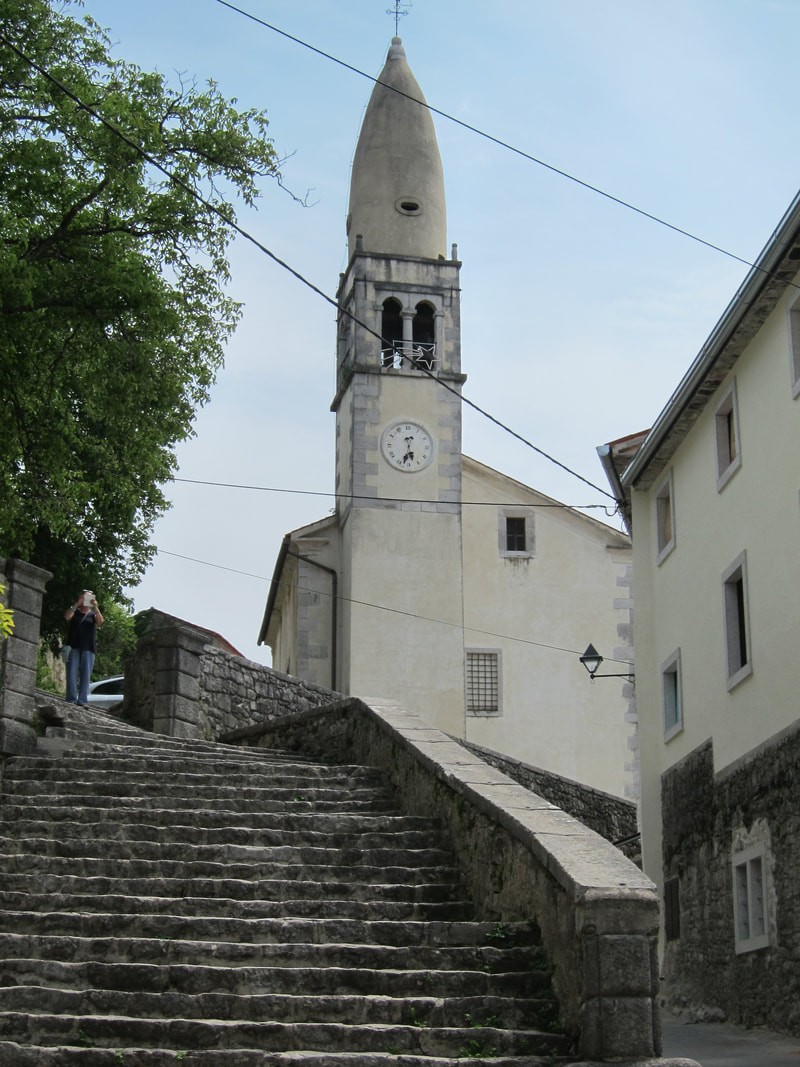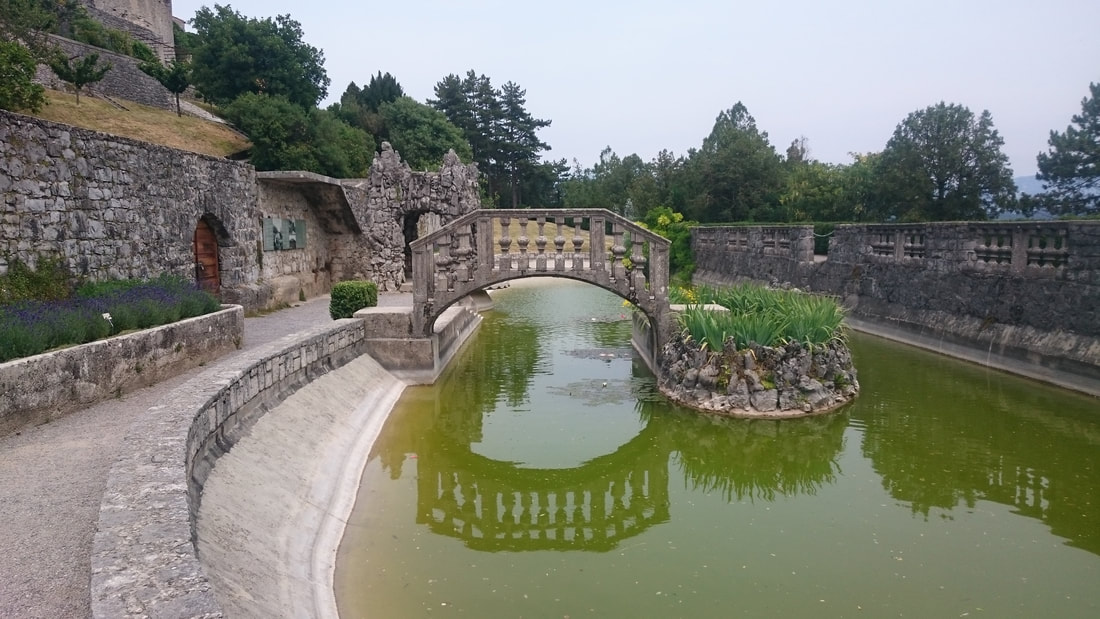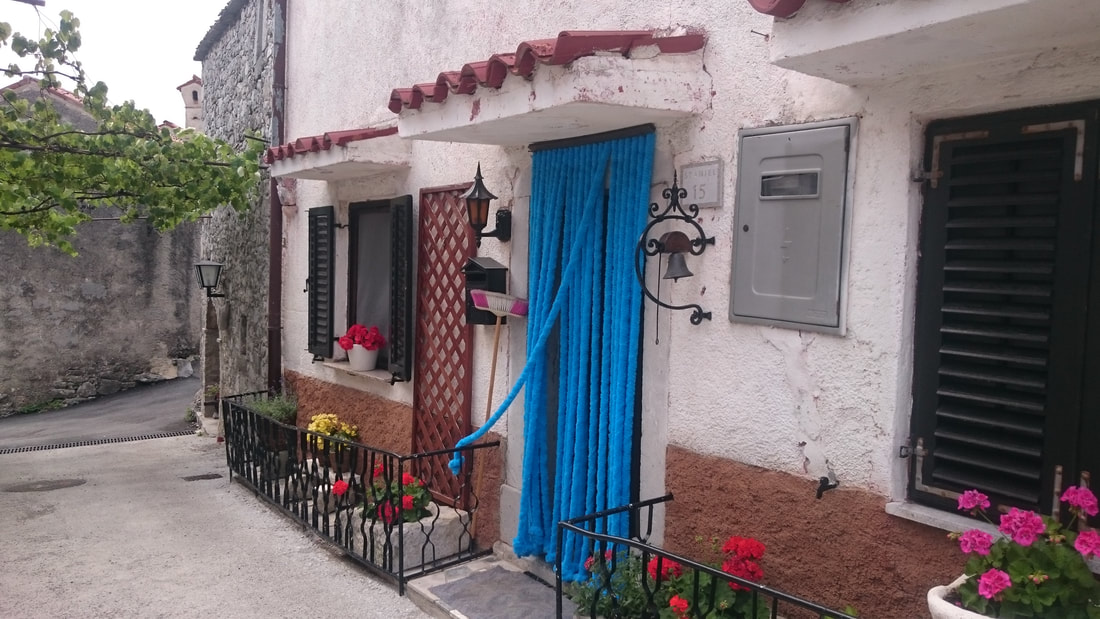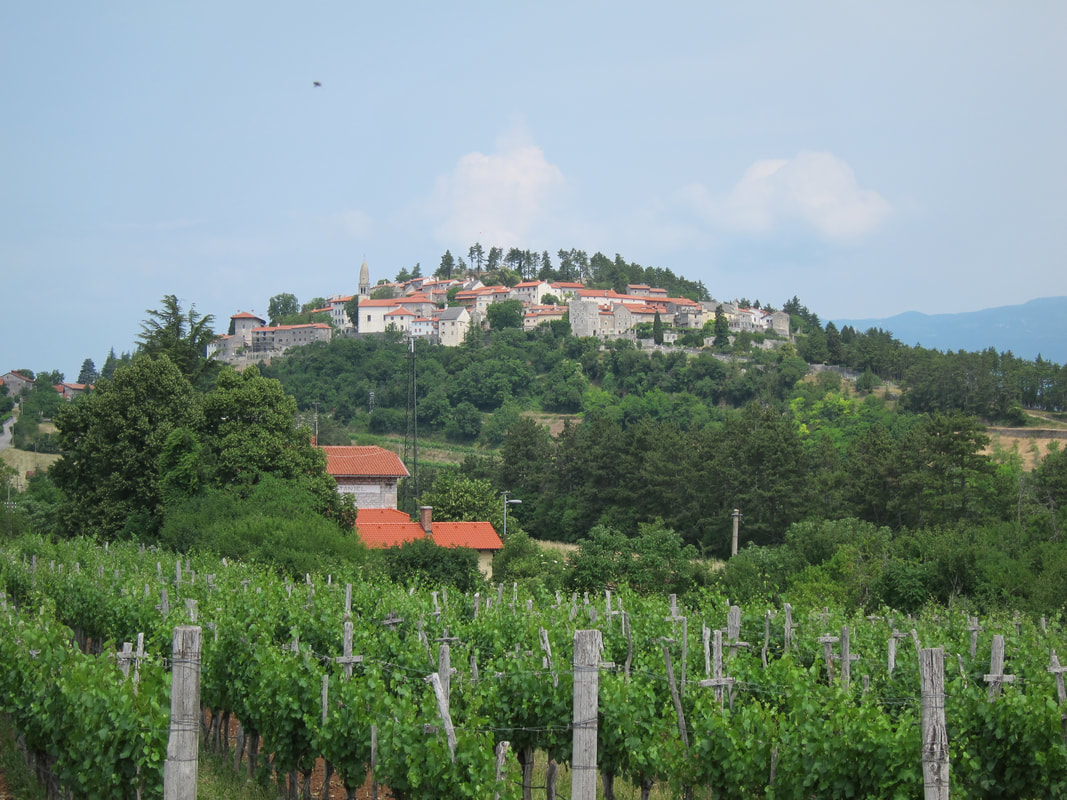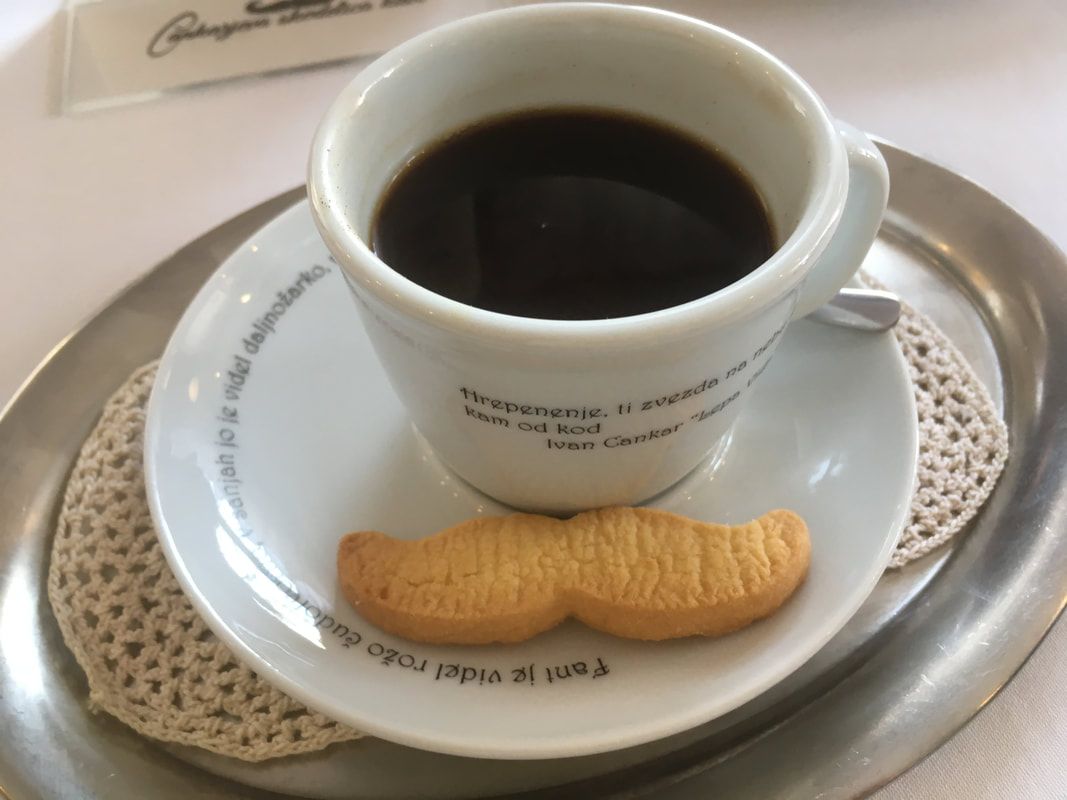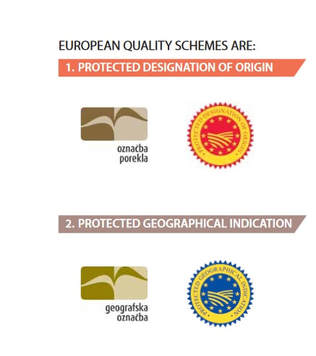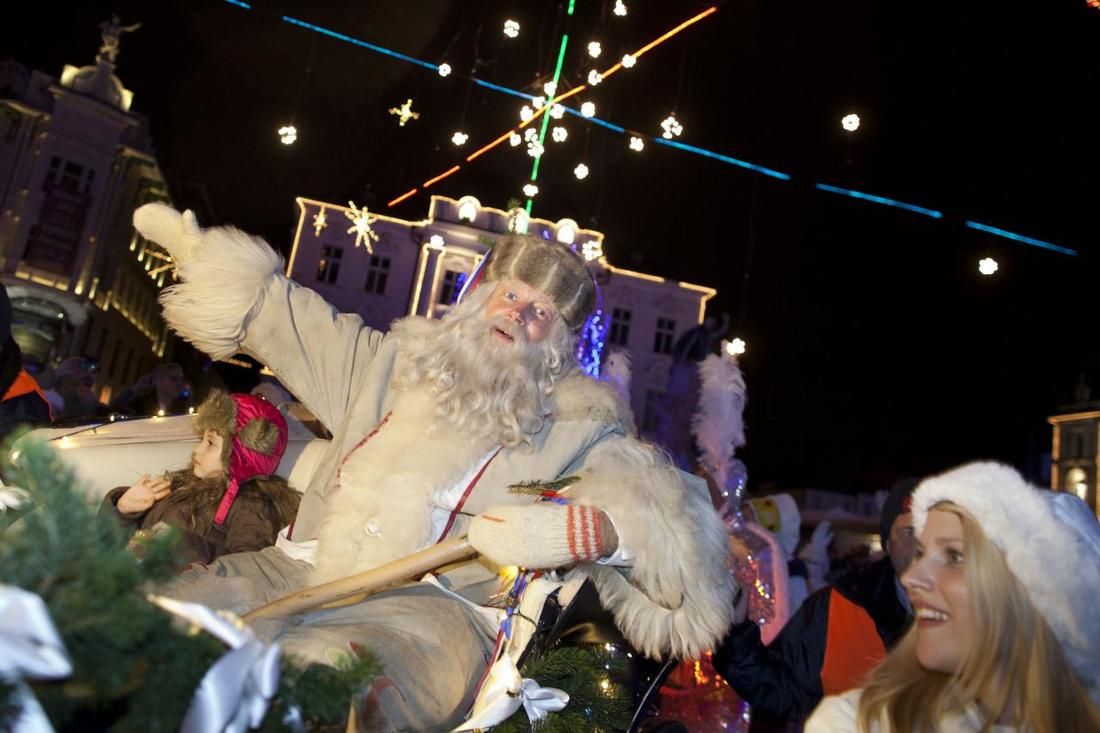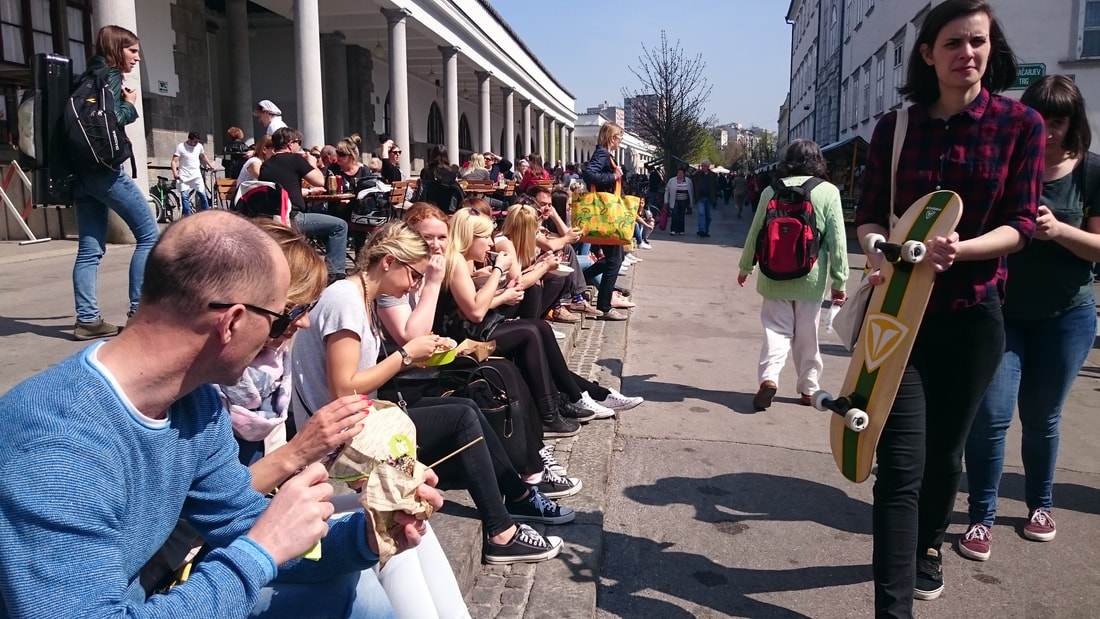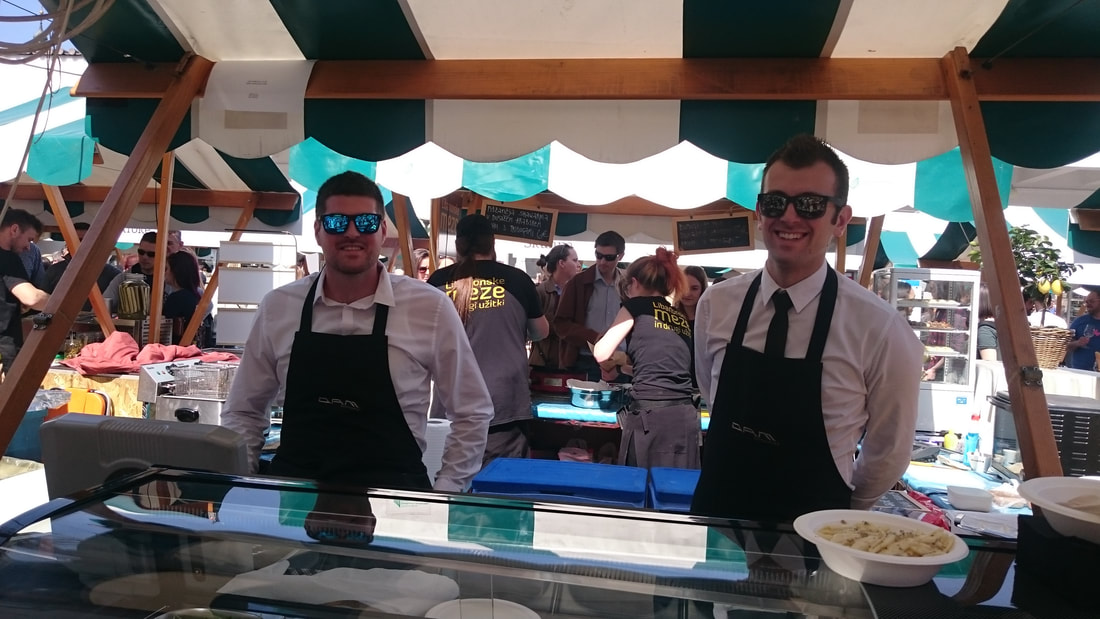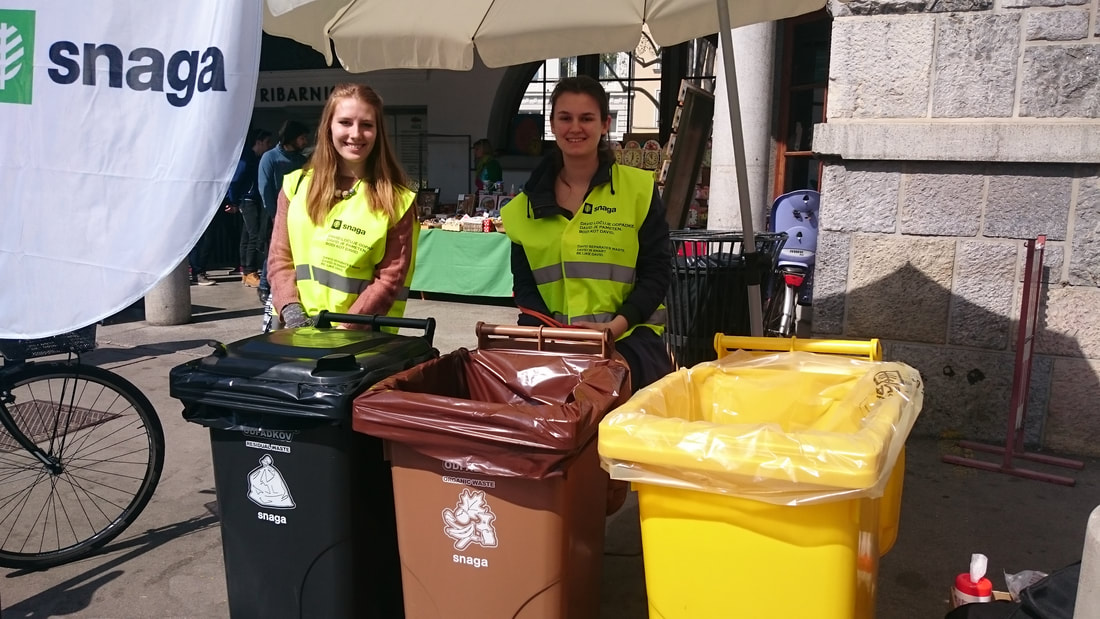|
Beautiful (krasni in Slovenian ), this adjective comes to mind when I think of the beautiful Karst (Kras in Slovenian) region of Slovenia. Because it's outstanding. The Slovenian word Garst, (Karst in English), which is supposedly the predecessor of today's name, was first mentioned in the 12th century. There are many similar geological phenomena in the world, there is even a science called karstology. It's a study for specific geological areas of limestone. I am not a scientist, but I also like to research, because of this, I am on my way because I am very interested in Kras. We go today to one beautiful Karst village, called Štaniel. Štanjel is located on a picturesque hill in an area called Komenski Kras. I assume that the village got its name right after the church of St. Daniel, standing next to the castle and which is seen from afar, known for its unusual belfry. Where does his form come from is unknown, nobody knows it clearly, neither the locals nor the scientists. This may be the charm of this belfry.
Of course, if you are in Štanjel, you must go to the Ferrari Garden, the creation of architect Max Fabiani, who has been declared a cultural monument of national importance since 1999. It is a small park, which, according to the plans of Max Fabiani, who is local (Max Fabiani was born in the neighboring village of Kobdilj, and for some time he was the mayor of Štanjel) who, at the request of his client, the nephew from Trieste, Enrico Ferrari , transformed the rocky part, the former defensive urban walls into one smaller sanatorium, but the Second World War broke the plane of Enrico Ferrari and his uncle. So after the war park has become a public space, and now the entrance to the park is always free. In recent times, various weddings often take place, including from foreign countries. For more demanding travelers, I would recommend a walk along the well-known "home" route, namely the path known as the Fabiani trail that runs between picturesque hills from Štanjel to Kobdilj. The path is circular and it is about 4 km long, which means about 3 hours of slow walking, if, of course with all 26 information points. So, if you still walk along the Štanjel town, try ham, teran terrarossa local wine and taste the karst honey. Beau (krasni en slovène), cet adjectif vient à mon esprit quand je pense à la belle région de Karst (Kras en slovène) en Slovénie. Parce qu'il est exceptionnel. Le mot slovène Garst, (Karst en anglais), qui est censé être le prédécesseur du nom d'aujourd'hui, a été mentionné pour la première fois au 12ème siècle. Il existe de nombreux phénomènes géologiques similaires dans le monde, il y a même une science appelée karstologie. C'est une étude pour des zones géologiques spécifiques de calcaire. Je ne suis pas un scientifique, mais j'aime aussi faire de la recherche, à cause de cela, je suis mon chemin de découverte parce que je m'intéresse beaucoup à Kras. Nous allons aujourd'hui dans un beau village karstique, appelé Štaniel. Štanjel est situé sur une colline pittoresque dans une zone appelée Komenski Kras. Je suppose que le village a pris son nom après l'église de Saint-Daniel, qui se trouve à côté du château et qui est vu de loin, connu pour son clochet inhabituel. D'où vient sa forme est inconnue, personne ne le sait clairement, ni les habitants ni les scientifiques. Cela peut être le charme de ce clochet. Bien sûr, si vous êtes à Štanjel, vous devez aller au jardin Ferrari, la création de l'architecte Max Fabiani, qui a été déclaré monument culturel d'importance nationale depuis 1999. C'est un petit parc, qui, selon les plans de Max Fabiani, qui est local (Max Fabiani est né dans le village voisin de Kobdilj, et pendant quelque temps il était le maire de Štanjel) qui, à la demande de son client, son neveu de Trieste, Enrico Ferrari, a transformé la partie rocheuse , les anciens murs urbains défensifs dans un sanatorium plus petit, mais la Seconde Guerre mondiale a brisé les idées d'Enrico Ferrari et son oncle. Donc, après que le parc de guerre il est devenu un espace public, et maintenant l'entrée du parc est toujours libre. Ces derniers temps, divers mariages ont souvent lieu, y compris de l'étranger. Pour les voyageurs plus exigeants, je recommande une promenade le long de la fameuse route «locale», à savoir le sentier connu sous le nom de sentier Fabiani qui relie les collines pittoresques de Štanjel à Kobdilj. Le chemin est circulaire et il fait environ 4 km de long, ce qui signifie environ 3 heures de marche assez lente, si, bien sûr, avec tous les 26 points d'information. Donc, si vous continuez à marcher le long de la ville de Štanjel, essayez le jambon, le teran le vin de terrarossa et goûtez le miel karstique.
1 Comment
Vrhnika is a tiny Ljubljana suburb town, situated just 21 km from the capital city, despite its small size and just 8.000 inhabitants it has a very rich history. During the Roman times it was known as Nauportus, and it served as an important communication point to spread the Empire and to conquer the rest of the region, during the Austrian times it was known as Oberlaibach, Laibach was a German name for Ljubljana, by the way. Vrhnika is known by all Slovenians because of the famous Ljubljanica river which starts there and has at least 3 big springs : Močilnik , Retovje and Bistra. In Bistra, by the way, in an ancient castle we have the biggest Slovenian museum, Technical Museum of Slovenia , where you can see, of course among hundred of others interesting objects, the private collection of Tito cars. Recently, in Vrhnika a new cultural center Moja Ljubljanica /My Ljubljanica/ was inaugurated and its exhibition is dedicated to all findings from Ljubljanica river and, beleive me, you have a lot of nice findings there, one of the star of the collection is a wooden point of a spear, which is 40.000 years old, the oldest wooden point ever found in the world. The museum is also good equipped for handicapped people. This modern exhibition with archaeological findings can be interesting for both, adults and kids. Vrhnika is also the birthplace of the most known Slovenian writer of Modernism, Ivan Cankar (1876-1918). His sad, deep and highly talented literal works are as popular here, as his charming mustache, so Vrhnika inhabitants are very proud, so now one’s can drink a perfect “cup of coffee” /the name of famous literal work of Ivan Cankar/ and eat the moustache shaped biscuit. Very tasty, go and try yourself! ;) Now, for sure, you will think I am joking, but the famous ancient Greek, hero Jason, the one, who has stolen the golden fleece in Cochis, the kingdom on the Black Sea /present day Georgia/ was also in Vrhnika! With his friends Argonauts he had to spend winter in the region, and the print of his boat Argo is still seen on one of the the rock in Vrhnika, that's why every year in June we have Argonaut Days. More information you have here http://www.visitvrhnika.si/en/things-to-do/traditional-events/the-argonaut-days-and-noc-na-vrhniki The proof , that all is this is true, that is Vrhnika still has its city coat of arms as Argo ship, the famous ship of Jason and the Argonauts. Have a look here, it is a municipality website : https://www.vrhnika.si/, you see, I was right! ) Plenty of interesting sites are in Vrhnika and around: Ljubljana Marshes, Planina Hill, The nature reserve Mali Plac, “Human fish” microbrewery, Bevke natural trail and many other nice things are to do and to see there! Vrhnika est une petite ville de banlieue de Ljubljana, elle est située à seulement 21 km de la capitale, malgré sa petite taille et seulement 8 000 habitants son histoire est très riche. À l'époque romaine, elle était connue sous le nom de Nauportus et servait de point de communication importante pour propager l'Empire et pour conquérir la région. Pendant l'époque autrichienne, elle était connue sous le nom d'Oberlaibach, Laibach était un nom allemand pour la ville de Ljubljana. Vrhnika est connue par tous les Slovènes à cause de la fameuse rivière Ljubljanica qui y commence et qui compte au moins 3 grandes sources: Močilnik, Retovje et Bistra. À Bistra, à propos, dans un ancien château, nous avons le plus grand musée slovène, Musée technique de Slovénie, où vous pouvez voir, bien sûr parmi d'autres beaux objets, la collection privée de voitures de Tito. Récemment, à Vrhnika, un nouveau centre culturel Moja Ljubljanica /Ma Ljubljanica/ a ouvert ses portes. Il est dédié à toutes les découvertes de la rivière Ljubljanica et, selon moi, vous avez beaucoup de trouvailles, une des vedettes de la collection archéologique qui a 40.000 ans, est la pointe en bois de la lance la plus ancienne, jamais trouvée au monde. Le musée est également bien équipé pour les personnes handicapées et son exposition moderne peut être intéressante pour les adultes et pour leurs enfants. Vrhnika est également le lieu de naissance de l'écrivain slovène le plus connu, moderniste Ivan Cankar (1876-1918). Ses œuvres littéraires tristes, profondes et très talentueuses sont aussi populaires ici que sa charmante moustache, donc les habitants de Vrhnika sont très fiers, alors maintenant on peut boire « une tasse de café » parfaite /le nom de l'œuvre littéraire célèbre d'Ivan Cankar/ et manger le biscuit en forme de moustache. Très savoureux, allez-y et dégustez vous-mêmes! ;) Maintenant, bien sûr, vous penserez que je blague, mais le célèbre ancien Grec, héros Jason, celui qui a volé la toison d'or à Colchide, au royaume sur la Mer Noire /aujourd'hui la Géorgie/ était également à Vrhnika! Avec ses amis Argonautes, il a dû passer l'hiver dans la région, et l'empreinte de son bateau Argo l’empreinte duquel est toujours visible sur l'un des rochers de Vrhnika, c'est pourquoi chaque année au mois de juin nous avons des Journées des Argonautes. Plus d'informations, vous avez ici : http://www.visitvrhnika.si/en/things-to-do/traditional-events/the-argonaut-days-and-noc-na-vrhniki La preuve, que tout cela est vrai, c'est que Vrhnika a toujours ses armoiries de la ville comme le bateau d’Argo, le fameux navire de Jason et des Argonautes. Jetez un coup d’œil ici et vérifiez vous-mêmes le site web de la municipalité: https://www.vrhnika.si/ . Vous voyez, j’avais raison ! ) Beaucoup de sites intéressants sont là à découvrir dans la ville et aux alentours de Vrhnika: les marais de Ljubljana, la colline de Planina, la réserve naturelle Mali Plac, la microbrasserie "Human Fish", le sentier naturel de Bevke et bien d'autres choses intéressantes à faire et à voir! Slovenia is a country of various traditions and customs and, probably, the most pleasant way to visit Slovenia is tasting its various and rich cuisine. For such small territory we have plenty of local products which are protected and certified, so the quality and authenticity is guaranteed. To help you to learn more about this nice side of tourism, here in Slovenia, let's check some of the most known. First of all, you have two main types of products: some are » protected designation of origin« , some are » protected geographical Indication«. Here are the signs which can help you to distinguish these two groups: Here is the list of products which have sign » protected designation of origin«. Please, remember them well, so you will be able to distinguish these products from hundreds of other quality products in Slovenia ) So, let's start :
I hope, when you come to Slovenia, you will taste all these outstanding, very tasty, organic and high quality dishes. Dober tek! Good appetite! ;) And now.... I have to show off a bit ... Sorry it's my job ;) Some information and pics were used from official page of the Ministry of Agriculture, Forestry and Food
You may ask why a Happy December? It is cold, in Ljubljana there is a famous Ljubljana fog, it's humid, the day is too short, and there is no sun! Why then Slovenians have named December, a Happy December?! If you still doubt, then read the entire article :) All this is true, but the joy is around and it lasts a whole month! Slovenians have three dates for getting gifts this month!!!! Can you imagine the happiness of Slovenian kids in December? At the beginning of December, Slovenian children are visited by somebody very “local”. Saint Nicholas ( Sveti Miklavž) visits us on December the 5th, he is visiting our homes, distributing sweets and candies to the kids, but he is not alone, by him ones can see Angels and horrible Krampuses. The Krampus look so horrible, that even adults are afraid of them. If you don’t believe me, you can visit a festival “The night of Krampus in Goričane” and you will see that I am right...;) Last years, following the tradition of the western world, since Slovenia is mostly a Catholic country, is logic that we celebrate Christmas. And because of this, some Slovenian children receive their gifts on that day. All over Slovenia, in churches, at home, ones can see Nativity scene. Some famous tourist places, like the Postojna cave, make a live show with actors to present the birth of little Jesus (https://www.postojnska-jama.eu/en/get-to-know-the-park/events/living-nativity-scenes-in-postojna-cave/?RemeberLocale=1) And, of course, as a country, that once was a part of the communist world for some time, Slovenia has also a special guest at the end of the month, and this is Slovenia's Dedek Mraz (literal translation “Grandfather Frost” , which first has appeared in ex-Yugoslavia in 1947, his home is at the biggest mountain in Slovenia, Triglav. Now you better know why, here in Slovenia, we love December and we call it Happy December… But, please, don’t ask me anything about January, because I think at that time I will have a headache ))))
Welcome to Slovenia also in winter! Who would believe that dragon can help to the city to promote it among the tourists? Paris has the Eiffel Tower, Egypt has the Pyramids, Greece has the Acropolis, but we have our Dragon, the Ljubljana Dragon. Ljubljana people are proud of this symbol. The "protector" of the city has its own bridge and while you are in Ljubljana this the place to be. Like somebody says: "This is the most photographed Dragon in the world!" The Dragon bridge (1901) The Dragon bridge was built at the beginning of the 20th century in a Secession style and, of course, it's a nice bridge, so what? Why this dragon is "the most photographed in the world"? There is no Ljubljana without the Dragon, which is on its coat of arms, by the way, and of course!, there is no Dragon bridge without the Dragon... no doubt! ) The are two legends about the dragon... First is about... Surprise! :) I propose you to look a film, so, you ll be able to improve you French and Slovenian, because it is in French and Slovenian :) ... or maybe to google about the Dragon of Ljubljana... or maybe simply come next year to Ljubljana and discover the story by yourself or with the help of a local guide, which is the best way to discover the city ;) So, its you decision. About the film: This film "Le trésor caché de Ljubljana" was filmed by Canadian students from Montreal this summer. They came to Ljubljana to discover the legend about the Dragon. So popular it is! ;) We have met , a bit accidentally, :) you know , life is life, but it is another story, and I am happy that I could help them, because when I was a student, I also sometimes needed help, so I give back, what I have got :) and the film is good done, so I wish all the best to this team and I hope that they have got a good mark for their work :) Qui pourrait croire qu'un dragon peut aider à la ville et la promouvoir parmi les touristes? Paris a la Tour Eiffel, l'Egypte a les Pyramides, la Grèce a l'Acropole, mais nous, nous avons notre dragon, le Dragon de Ljubljana. Les gens de Ljubljana sont fiers de ce symbole. Le "protecteur" de la ville a son propre pont et pendant que vous êtes à Ljubljana c'est l'endroit à visiter . Comme quelqu'un a dit: "C'est le Dragon le plus photographié au monde!"
Le Pont de dragon a été construit au début du 20ème siècle dans le style Art Nouveau et, bien sûr, c'est un joli pont.... et alors? Pourquoi ce dragon est-il donc "le plus photographié au monde"? Car, il n'y a pas de Ljubljana sans le dragon, et il n'y a pas de Pont de Dragon, lui-même, sans le Dragon .... ce qui est évident :) , d'ailleurs, on le vois aussi sur les armoiries de la ville. Il existe deux légendes sur le dragon ... La première parle de ... Surprise! :) Je vous propose de regarder le film, donc, vous pourrez vous améliorer votre slovène, parce que c'est en français et en slovène :) ... ou peut-être, vous pouvez googler sur Internet en cherchant mot-clés "Ljubljana", "dragon de Ljubljana" etc... ou peut-être, simplement venir l'année prochaine à Ljubljana et découvrir l'histoire par vous-même ou avec l'aide d'un guide local (e), ce qui est mieux ;) Donc, c'est à vous de choisir. À propos du film: Le film «Le trésor caché de Ljubljana» a été filmé cet été par les étudiants canadiens de Montréal, venus à Ljubljana pour découvrir la légende de notre Dragon . C'est tellement populaire! ;) Nous nous sommes rencontrés un peu par hasard :) vous savez, c'est la vie ! :), mais c'est une autre histoire, et je suis heureuse d'avoir pu les aider, parce que quand j'étais étudiante, j'avais aussi parfois besoin d'aide de quelqu'un :) et, en plus, le film est très bien fait, donc, je souhaite tout le meilleur à cette équipe et j'espère qu'ils ont eu une bonne note pour ce film :) 5 REASONS WHY IT IS TRUE 1. Ljubljana’s city centre, which was once home to a constant slew of cars and buses, is now mostly dedicated to pedestrians and cyclists. In 2015, Ljubljana first made it onto the list of top 20 bicycle friendly cities in the world taking the 13th place, and this year it improved its ranking. 2. The city is the European capital with the highest share of separated waste that is collected, at 63%. 3.In the City of Ljubljana we are aware of the significance of bees for our survival, therefore we pay special attention to them. At the competition for the Most Bee-Friendly Municipality 2016 the City of Ljubljana was placed third. 4. Ljubljana's electric-powered vehicles referred to as Kavalirs (Gentle Helpers) are a free city centre public transport option friendly both to people and the environment. 5. The Ljubljana area boasts four nature parks! One of them covers the area of the wooded Rožnik and Šišenski hrib hills and Ljubljana's most beautiful park, Tivoli. FAMOUS SLOVENIAN TRADITIONAL BAKERY Of course you all know, that lately our little and lovely Slovenia became more popular...one of the reason is because Melania Trump, the First Lady of the USA, is originally from Slovenia, more exactly, from the little town on the Sava river, called Sevnica. And maybe you have heard that during Melania and Donald Trump's visit to the Vatican, First Lady was talking with Pope Francis about our POTICA (pronounced poh-TEET-sah)!!! Slovenians are having POTICA for special occasions or holidays. Slovenia, it’s a small country, but it’s very diverse, as well as its cuisine. Recently, I went to discover how to make a pottery for this traditional bakery, because without this pottery you can't make a real POTICA !!! Somebody, who has already worked with a clay will know, that this not an easy pottery model to do, but our potter, Mr.France Kremžar, who keeps the old tradition of pottery making in a little village of Komenda not far from Ljubljana, did it in 5 minutes. I am a witness :) I propose you to see the process. During this video you can't see me, but you can hear my voice and my Slovenian ) Welcome to Slovenia to discover the old Slovenian traditions! |

